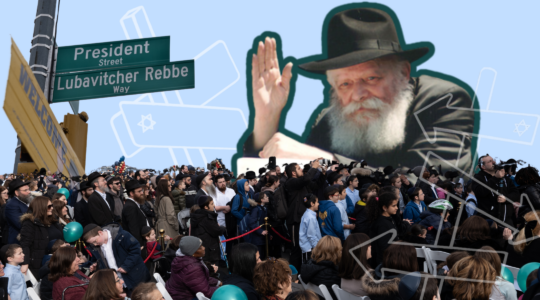School board battles around the country, whether they are about textbook content, class reading lists or budgets, tend to be heated affairs, where emotions run high. But the one brewing in suburban Ramapo, home to a politically powerful Orthodox community, is particularly charged.
A complex set of issues — race, identity politics, voting rights and local taxes — creates a potent mix as the town, about 30 miles north of Manhattan, braces for a lawsuit brought by the Spring Valley NAACP against the East Ramapo Central School District.
Though tensions between blacks and Orthodox Jews over the local school board’s actions have been simmering for some years, the lawsuit, which is headed for trial next month, arrives at an awkward moment, to say the least. A brazen knife attack allegedly carried out by an African-American man at the home of a rabbi in nearby Monsey, which injured five on the seventh night of Chanukah, has Orthodox residents on edge.
But the school board battle predates that attack (and other widely reported recent incidents of anti-Semitism). Originally filed by the NAACP in November 2017, the lawsuit claims that an Orthodox majority on the nine-member East Ramapo school board is the result of an at-large election system effectively rigged against black and Latino voters.
The suit cites the Voting Rights Act of 1965, federal legislation intended to prohibit racial discrimination in voting.
The school district counters that contrary to the claim of racial bias, minorities are extremely active and successful in District politics, noting that three of the nine current members of the school board are people of color. In a motion for summary judgment filed by the District in March 2019 and ultimately denied by the judge, the District argued that the NAACP takes issue with the minority candidates who win, because they work closely with the Orthodox community on policy.
The District also objects to the NAACP’s use of the descriptors “white community” and “private school community,” used in the original complaint, arguing that the terms are “euphemisms” for Orthodox Jews, whose children overwhelmingly attend parochial schools. (In its subsequent response, the NAACP maintains that a significant portion of the white community is “Orthodox Jewish, the Orthodox Jewish community is almost exclusively white, and the District’s residents frequently use racial and religious terms interchangeably.”)
The political divide between East Ramapo’s Orthodox Jewish residents and its black and Latino residents goes back 15 years and more. The nine-member East Ramapo school board first gained an Orthodox majority in 2005 and has kept an Orthodox majority ever since. Majority members of the board, voted in by families whose children attend yeshivas, have voted to cut taxes and budgets, citing fiscal responsibility; the District’s non-Orthodox residents say the Orthodox board members have gutted the public school system and diverted money from public to private schools.
In 2014, the resulting decline of the District’s public schools led to the appointment by New York State of “monitors” to oversee the district’s finances — and eventually to funds earmarked for public school services, to relieve some of the need for program and faculty cuts. Orthodox leaders called the monitor system “infantilizing,” and said it overrode the interests of a democratically elected majority.
Democracy, or ‘control’?
Despite the monitors and additional funding, the NAACP maintains in the lawsuit that the “State’s intervention is necessary, but not sufficient, to ensure that the interests of the District’s Minority children and residents are protected.”
The NAACP lawsuit contends that the district’s at-large voting system “allows the majority community – which is white, lives close together, and tends to vote as a political bloc favoring private school education – to control eight of the board’s nine seats,” according to a statement by the New York Civil Liberties Union, whose lawyers are representing the NAACP.
The plaintiffs prefer a ward system, which would allow board members to be elected from nine member-districts.
Attorneys representing the NAACP of Spring Valley and the East Ramapo Center school district declined to comment at this time due to ongoing litigation.
Harry Grossman, president of East Ramapo’s board of education and a member of the local Orthodox community, told The Jewish Week that the board rejects a ward system.
“The problem with a ward system is that it would entrench segments against one another, making the problem worse,” he said in a phone interview. (Grossman spoke to The Jewish Week as a private citizen, not as a spokesperson for the board or the school district.)
Grossman, a resident of East Ramapo for 22 years, said he ran for the board in the hopes that his non-Orthodox upbringing (as a Conservative Jew) could help “bridge chasms” within the community. He reiterated the importance of “unity” within the community, and said he has seen school conditions “improve dramatically” since he joined the district five years ago. He cited the 2015 appointment of Deborah L. Wortham as the district’s new superintendent of schools.
Identity politics
An undercurrent of identity politics is evident throughout the lawsuit, though Grossman and others argue that “race has nothing to do with voting in the District.”
“The real purpose of the lawsuit is to promote candidates whose tax, political and educational policies the plaintiffs prefer…That’s not a fight we should be having in court,” Grossman wrote in a recent op-ed submitted to Lohud, a news outlet owned by the USA Today network that covers the Lower Hudson Valley. According to Grossman, Lohud declined to publish Grossman’s article, which was intended as a response to an opinion piece published in June 2019 that criticized the District.
Ed Forbes, senior director of news and engagement for the Lohud, said Grossman’s article was “not rejected for publication.”
“Mr. Grossman’s op-ed piece was submitted during a period last summer in which Lohud and The Journal News were not regularly publishing community-generated opinion pieces,” Forbes told The Jewish Week via email.
The plaintiffs have been critical of the three current board members who are people of color. In a letter appended to the complaint, two local members of the NAACP said the three members “support a pro-segregation agenda that plunders the public school budget and privileges a racially and religiously segregated sector of the community. This is what the Hasidic bloc of the school board has dedicated itself to doing, and this is what we believe the three new board members have signed on to do also.”
The letter, addressed to Hazel Dukes, president of the NAACP New York State Conference, was signed by Willie Trotman, president of the Spring Valley NAACP, and Oscar Cohen, a Jewish civil rights activist and co-chair of the chapter’s education committee.
Private school students outnumber public school students in East Ramapo by three-to-one. According to the New York State Education Department, the East Ramapo Central School District serves approximately 8,472 public school students at 14 schools. Over 27,000 private school students attending approximately 150 private schools, the overwhelming majority of which are Orthodox Jewish day schools, and also receive public funds for busing and other services. Black and Latino children constitute over 90 percent of the public school students, according to the data.
Members of the Rockland County Orthodox community complain that they are often subject to anti-Semitic invective from non-Orthodox neighbors. In August 2019 the Rockland County Republican Party ran a Facebook video that was derided as anti-Semitic by the state Attorney General Leticia James and the Republican Jewish Coalition.
Local Orthodox Jews and their political leaders say such demonizing of the Jewish community is in part responsible for a spate of violent attacks in the New York area, including the machete attack in Monsey, the deadly shooting at a kosher grocery in Jersey City last month and frequent street attacks on Orthodox Jews in Brooklyn.
“Perhaps the biggest problem is that chasidic and ultra-Orthodox Jews are denigrated because they look different,” said Grossman. He pointed to Peter Bradley, a member of the Clarkstown Town Council in Rockland County, who differentiated between “normal Jews” and Chasidic Jews in a Facebook post less than two weeks after the Pittsburgh synagogue shooting in which 11 worshippers were killed. (Bradley apologized for the comment.)
The New York Jewish Week brings you the stories behind the headlines, keeping you connected to Jewish life in New York. Help sustain the reporting you trust by donating today.




